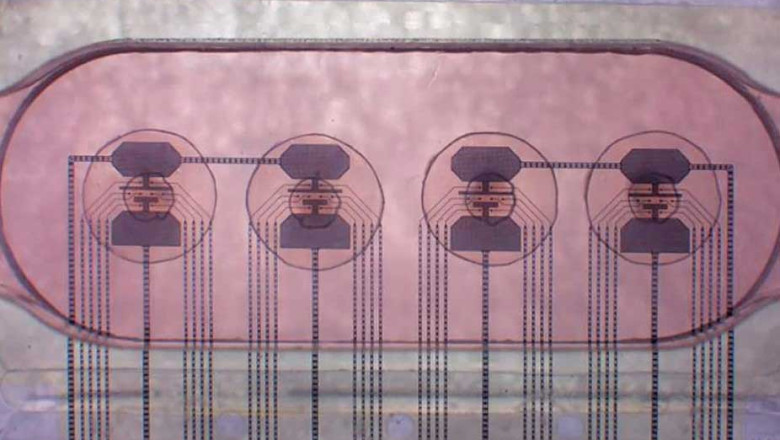
views
Biocomputing technology, which merges living human neurons with advanced hardware, marks a groundbreaking advance that could redefine the future of artificial intelligence and biomedical research. Companies like Swiss FinalSpark and Australian startup Cortical Labs are pioneering commercial platforms that harness lab-grown human brain cells to create highly energy-efficient and learning-capable biological computers, also known as "wetware."
Leading Biocomputing Platforms
Swiss startup FinalSpark offers the Neuroplatform, the world's first commercial bioprocessor accessible remotely via the internet for $500 per month. It uses clusters of living human brain organoids placed on multi-electrode arrays (MEA) that electrically stimulate and record neural activity. This platform hosts up to 16 mini "brains" and is already used by researchers at over 30 universities globally, enabling cutting-edge experimentation in biological computation.tomshardware+3
Australia’s Cortical Labs launched the CL1, a commercial biological computer priced around $35,000, which integrates about 800,000 lab-grown human neurons with silicon chips. The CL1 system processes information via electrical feedback loops and features an advanced internal life support unit capable of maintaining neurons alive for six months. Designed for medical and research labs, it provides an ethical alternative for neural function analysis and drug discovery.biopharmatrend+4
Unmatched Energy Efficiency
One of the most transformative aspects of biocomputing lies in its energy consumption. Biological neurons operate with vastly greater efficiency than silicon transistors, requiring between 1,000 to 1,000,000 times less energy per computation. For comparison, the human brain uses around 20 watts to perform tasks comparable to supercomputers that consume megawatts of power. FinalSpark’s co-founder Fred Jordan highlights this advantage, aiming to enable AI training at 100,000 times less energy than current state-of-the-art systems. Such breakthroughs promise to mitigate the escalating environmental impact of growing AI data centers and computational demands.bioalps+2
Medical and Research Applications
Biocomputing platforms enable sophisticated models of human brain function, surpassing the limitations of traditional animal models. Researchers at Johns Hopkins University and elsewhere use brain organoids to investigate diseases like autism and Alzheimer's by studying neuronal network changes in patient-derived cells. These models allow real-time tracking of neural activity and responses to drugs, offering more relevant insights for neurological diseases. The CL1, for example, facilitates long-term studies of brain function, drug effects, and neurological disorder mechanisms, providing crucial nuance often missed in clinical trials.meduniwien+3
Future Prospects
As biocomputing continues to advance, it is expected to transform AI architectures by enabling continuous learning, fast decision-making, and ultra-low power computing. The fusion of brain organoids with microfluidics, multi-electrode arrays, and AI training opens pathways to "intelligence-in-a-dish" with potential applications in personalized medicine, neurodegenerative disease research, and new drug discovery platforms.frontiersin+3
Sources:
-
FinalSpark Neuroplatform and research effortsbusinesswire+4
-
Cortical Labs CL1 biological computercorticallabs+5
-
Medical research using brain organoids and organoid intelligencepublichealth.jhu+3
-
Energy efficiency and AI implicationsscientificamerican
- https://www.tomshardware.com/pc-components/cpus/worlds-first-bioprocessor-uses-16-human-brain-organoids-for-a-million-times-less-power-consumption-than-a-digital-chip
- https://bioalps.org/finalsparks-neuroplatform-the-era-of-organic-computing-has-begun/
- https://www.businesswire.com/news/home/20240515701469/en/FinalSpark-Launches-the-First-Remote-Research-Platform-Using-Human-Neurons-for-Biocomputing
- https://finalspark.com/neuroplatform/
- https://www.biopharmatrend.com/news/cortical-labs-introduces-biological-computer-built-on-human-brain-cells-1156/
- https://corticallabs.com
- https://corticallabs.com/cl1.html
- https://www.forschung-und-wissen.de/nachrichten/technik/erster-kommerzieller-computer-mit-menschlichen-hirnzellen-erhaeltlich-13379997
- https://newatlas.com/brain/cortical-bioengineered-intelligence/
- https://www.scientificamerican.com/article/these-living-computers-are-made-from-human-neurons/
- https://www.meduniwien.ac.at/web/en/ueber-uns/news/2024/news-im-mai-2024/gehirnorganoid-fuer-forschung-entwickelt/
- https://www.frontiersin.org/journals/science/articles/10.3389/fsci.2023.1017235/full
- https://publichealth.jhu.edu/2025/johns-hopkins-team-finds-lab-grown-brain-organoids-show-building-blocks-for-learning-and-memory
- https://www.frontiersin.org/journals/artificial-intelligence/articles/10.3389/frai.2024.1376042/full
- https://www.sciencedirect.com/science/article/pii/S294992162500002X
- https://pubmed.ncbi.nlm.nih.gov/37009773/
- https://en.wikipedia.org/wiki/Organoid_intelligence
- https://finalspark.com
- https://futurezone.at/science/biologischer-computer-cl1-gehirnzellen-cortical-labs-ki-synthetic-biological-intelligence/403017378
- https://www.youtube.com/watch?v=3KeC8gxopio




















Comments
0 comment